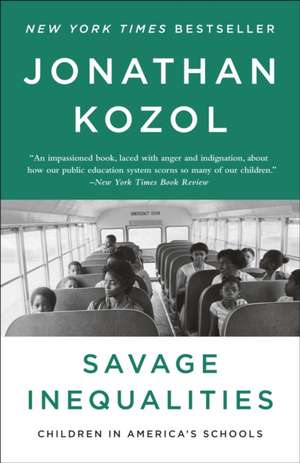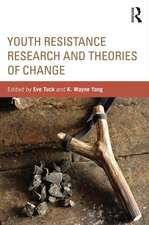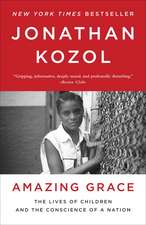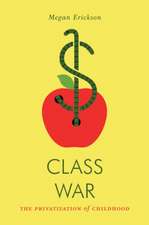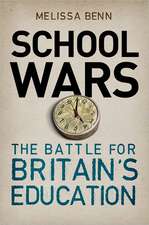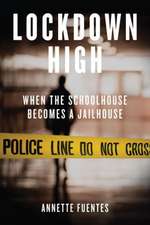Savage Inequalities: Children in America's Schools
Autor Jonathan Kozolen Limba Engleză Paperback – 30 iun 2012
In Savage Inequalities, Kozol delivers a searing examination of the extremes of wealth and poverty and calls into question the reality of equal opportunity in our nation’s schools.
Preț: 101.45 lei
Nou
Puncte Express: 152
Preț estimativ în valută:
19.41€ • 21.08$ • 16.31£
19.41€ • 21.08$ • 16.31£
Carte disponibilă
Livrare economică 01-15 aprilie
Preluare comenzi: 021 569.72.76
Specificații
ISBN-13: 9780770435684
ISBN-10: 0770435688
Pagini: 318
Dimensiuni: 135 x 203 x 18 mm
Greutate: 0.25 kg
Editura: BROADWAY BOOKS
ISBN-10: 0770435688
Pagini: 318
Dimensiuni: 135 x 203 x 18 mm
Greutate: 0.25 kg
Editura: BROADWAY BOOKS
Extras
Chapter One
Life on the Mississippi: East St. Louis, Illinois
East St. Louis lies in the heart of the American Bottoms—the floodplain on the east side of the Mississippi River opposite St. Louis. To the east of the city lie the Illinois Bluffs, which surround the floodplain in a semicircle. Towns on the Bluffs re predominantly white and do not welcome visitors from East St. Louis.
“The two tiers—Bluffs and Bottoms—“ writes James Nowlan, a professor of public policy at Knox College, “have long represented…different worlds.” Their physical separation, he believes, “helps rationalize the psychological and cultural distance that those on the Bluffs have clearly tired to maintain,” People on the Bluffs, says Nowlan, “overwhelmingly want this separation to continue.”
Towns on the Bluffs, according to Nowlan, do not pay taxes to address flood problems in the Bottoms, “even though these problems are generated in large part by the water that drains from the Bluffs.” East St. Louis lacks the funds to cope with flooding problems on its own, or to reconstruct its sewer system, which, according to local experts, is “irreparable.” The problem is all the worse because the chemical plants in East St. Louis and adjacent towns have for decades been releasing toxins into the sewer system.
The pattern of concentrating black communities in easily flooded lowland areas is not unusual in the United States. Farther down the river, for example, in the Delta town of Tunica, Mississippi, people in the black community of Sugar ditch live in shacks by open sewers that are commonly believed to be responsible for the high incidence of liver tumors and abscesses found in children there. Metaphors of caste like these are everywhere in the United States. Sadly, although dirt and water flow downhill, money and services do not.
The dangers of exposure to raw sewage, which backs up repeatedly into the homes of residents in East St. Louis, were first noticed, in the spring of 1989, at a public housing project, Villa Griffin. Raw sewage, says the Post-Dispatch, overflowed into a playground just behind the housing project, which is home to 187 children, “forming an oozing lake of…tainted water.” Two schoolgirls, we are told, “experienced hair loss since raw sewage flowed into their homes.”
While local physicians are not certain whether loss of hair is caused by the raw sewage, they have issued warnings that exposure to raw sewage can provoke a cholera or hepatitis outbreak. A St. Louis health official voices her dismay that children live with waste in their backyards. “The development of working sewage systems made cities livable a hundred years ago,” she notes. “Sewage systems separate us from the Third World.”
“It’s a terrible way to live,” says a mother at the Villa Griffin homes, as she bails raw sewage from her sink. Health officials warn again of cholera—and, this time, of typhoid also.
The sewage, which is flowing from collapsed pipes and dysfunctional pumping stations, has also flooded basements all over the city. The city’s vacuum truck, which uses water and suction to unclog the city’s sewers, cannot be sued because it needs $5,000 in repairs. Even when it works, it sometimes can’t be used because there isn’t money to hire drivers. A single engineer now does the work that 14 others did before they were laid off. By April the pool of overflow behind the Villa Griffin project has expanded into a lagoon of sewage. Two million gallons of raw sewage lie outside the children’s homes.
In May, another health emergency develops. Soil samples tested at residential sites in East St. Louis turn up disturbing quantities of arsenic, mercury and lead—as well as steroids dumped in previous years by stockyards in the area. Lead levels found in the soil around one family’s home, according to lead-poison experts, measure “an astronomical 10,000 parts per million.” Five of the children in the building have been poisoned. Although children rarely die of poisoning by lead, health experts note, its effects tend to be subtle and insidious. By the time the poisoning becomes apparent in a child’s sleep disorders, stomach pains, and hyperactive behavior, says a health official, “it is too late to undo the permanent brain damage.” The poison, she says, “is chipping away at the learning potential of kids whose potential has already been chipped away by their environment.”
The budget of the city’s department of lead-poison control, however, has been slashed, and one person now does the work once done by six.
Lead poisoning in most cities comes from lead-based paint in housing, which has been illegal in most states for decades but which poisons children still because most cities, Boston and New York among them, rarely penalize offending landlords. In East St. Louis, however, there is a second source of lead. Health inspectors think it is another residue of manufacturing—including smelting—in the factories and mills whose plants surround the city. “Some of the factories are gone,” a parent organizer says, “but they have left their poison in the soil where our children play.” In one apartment complex where particularly high quantities of lead have been detected I the soil, 32 children with high levels in their blood have been identified.
“I anticipate finding the whole city contaminated,” says a health examiner.
The Daughters of Charity, whose works of mercy are well known in the Third World, operate a mission at the Villa Griffin homes. On an afternoon in early spring of 1990, Sister Julia Huiskamp meets me on King Boulevard and drives me to the Griffin homes.
As we ride past blocks and blocks of skeletal structures, some of which are still inhabited, she slows the car repeatedly at railroad crossing. A seemingly endless railroad train tolls past us to the right. On the left: a blackened lot where garbage has been burning. Next to the burning garbage is a row of 12 white cabins, charred by fire. Next: a lot that holds a heap of auto tires and a mountain of tin cans. More burnt houses. More trash fires. The train moves almost imperceptibly across the flatness of the land.
Fifty years old, and wearing a blue suit, white blouse, and blue head-cover, Sister Juliapoints to the nicest house in sight. The sign on the front reads MOTEL. “It’s a whorehouse,” Sister Julia says.
When she slows the car beside a group of teen-age boys, one of them steps out toward the car, then backs away as she is recognized.
The 99 units of the Villa Griffin homes—two-story structures, brick on the first floor, yellow woods above—form one border of a recessed park and playground that were filled with fecal matter last year when the sewage mains exploded. The sewage is gone now and the grass is very green and looks inviting. When nine-year-old Serena and her seven-year-old brother take me for a walk, however, I discover that our shoes sink into what is still a sewage marsh. An inch-deep residue of fouled water still remains.
Serena’s brother is a handsome, joyous little boy, but troublingly thin. Three other children join us as we walk along the marsh: Smokey, who is nine years old, but cannot tell time; Mickey, who is seven; and a tiny child with a ponytail and big brown eyes who talks a constant stream of words that I can’t always understand.
“Hush, Little Sister,” says Serena. I ask for her name, but “Little Sister” is the only name the children seem to know.
“There go my cousins,” Smokey says, pointing to two teen-age girls above us on the hill.
The day is warm, although we’re only in the second week of March; several dogs and cats are playing by the edges of the marsh. “It’s a lot of squirrels here,” says Smokey. “There go one!”
“This here squirrel is a friend of mine,” says Little Sister.
None of the children can tell me the approximate time that school begins. One says five o’clock. One says six. Another says that school begins at noon.
When I ask what song they sing after the flag pledge, one says “Jingle Bells.”
Smokey cannot decide if he is in the second or third grade.
Seven-year-old Mickey sucks his thumb during the walk.
The children regale me with a chilling story as we stand beside the marsh. Smokey says his sister was raped and murdered and then dumped behind his school. Other children add more details: Smokey’s sister was 11 years old. She was beaten with a brick until she died. The murder was committed by a man who knew her mother.
The narrative begins when, without warning, Smokey says, “My sister has got killed.”
“She was my best friend,” Serena says.
“They had beat her in the head and raped her,” Smokey says.
“She was hollering out loud,” says Little Sister.
I ask them when it happened. Smokey says, “Last year.” Serena then corrects him and she says, “Last week.”
“It scared me because I had to cry,” says Little Sister.
“The police arrested one man but they didn’t catch the other,” Smokey says.
Serena says, “He was some kin to her.”
But Smokey objects, “He weren’t no kin to me. He was my momma’s friend.”
“Her face was busted,” Little Sister says.
Serena describes this sequence of events: “They told her to go behind the school. They’ll give her a quarter if she do. Then they knock her down and told her not to tell what they had did.”
I ask, “Why did they kill her?”
“They was scared that she would tell,” Serena says.
“One is in jail,” says Smokey. “They cain’t find the Other.”
“Instead of raping little bitty children, they should find themselves a wife,” says Little Sister.
“I hope,” Serena says, “her spirit will come back and get that man.”
“And kill that man,” says Little Sister.
“Give her another chance to live,” Serena says.
“My teacher came to the funeral,” says Smokey.
“When a little child dies, my momma say a star go straight to Heaven,” says Serena.
“My grandma was murdered,” Mickey says out of the blue. “Somebody shot two bullets in her head.”
I ask him, “Is she really dead?”
“She dead all right,” says Mickey. “She was layin’ there, just dead.”
“I love my friends,” Serena says. “I don’t care if they no kin to me. I care for them. I hope his mother have another baby. Name her for my friend that’s dead.”
“I have a cat with three legs,” Smokey says.
“Snakes hate rabbits,” Mickey says, again for no apparent reason.
“It’s a lot of hate,” says Smokey.
Later, at the mission, Sister Julia tells me this: “The Jefferson School, which they attend, is a decrepit hulk. Next to it is a modern school, erected two years ago, which was to have replaced the one that they attend. But the construction was not done correctly. The roof is too heavy for the walls, and the entire structure has begun to sink. It can’t be occupied. Smokey’s sister was raped and murdered and dumped between the old school and the new one.”
As the children drift back to their homes for supper, Sister Julia stands outside with me and talks about the health concerns that trouble people in the neighborhood. In the setting sun, the voices of the children fill the evening air. Nourished by the sewage marsh, a field of wild daffodils is blooming. Standing here, you wouldn’t think that anything was wrong. The street is calm. The poison in the soil can’t be seen. The sewage is invisible and only makes the grass a little greener. Bikes thrown down by children lie outside their kitchen doors. It could be an ordinary twilight in a small suburban town.
Night comes on and Sister Julia goes inside to telephone a cab. In another hour, the St. Louis taxis will not come into the neighborhood.
Life on the Mississippi: East St. Louis, Illinois
East St. Louis lies in the heart of the American Bottoms—the floodplain on the east side of the Mississippi River opposite St. Louis. To the east of the city lie the Illinois Bluffs, which surround the floodplain in a semicircle. Towns on the Bluffs re predominantly white and do not welcome visitors from East St. Louis.
“The two tiers—Bluffs and Bottoms—“ writes James Nowlan, a professor of public policy at Knox College, “have long represented…different worlds.” Their physical separation, he believes, “helps rationalize the psychological and cultural distance that those on the Bluffs have clearly tired to maintain,” People on the Bluffs, says Nowlan, “overwhelmingly want this separation to continue.”
Towns on the Bluffs, according to Nowlan, do not pay taxes to address flood problems in the Bottoms, “even though these problems are generated in large part by the water that drains from the Bluffs.” East St. Louis lacks the funds to cope with flooding problems on its own, or to reconstruct its sewer system, which, according to local experts, is “irreparable.” The problem is all the worse because the chemical plants in East St. Louis and adjacent towns have for decades been releasing toxins into the sewer system.
The pattern of concentrating black communities in easily flooded lowland areas is not unusual in the United States. Farther down the river, for example, in the Delta town of Tunica, Mississippi, people in the black community of Sugar ditch live in shacks by open sewers that are commonly believed to be responsible for the high incidence of liver tumors and abscesses found in children there. Metaphors of caste like these are everywhere in the United States. Sadly, although dirt and water flow downhill, money and services do not.
The dangers of exposure to raw sewage, which backs up repeatedly into the homes of residents in East St. Louis, were first noticed, in the spring of 1989, at a public housing project, Villa Griffin. Raw sewage, says the Post-Dispatch, overflowed into a playground just behind the housing project, which is home to 187 children, “forming an oozing lake of…tainted water.” Two schoolgirls, we are told, “experienced hair loss since raw sewage flowed into their homes.”
While local physicians are not certain whether loss of hair is caused by the raw sewage, they have issued warnings that exposure to raw sewage can provoke a cholera or hepatitis outbreak. A St. Louis health official voices her dismay that children live with waste in their backyards. “The development of working sewage systems made cities livable a hundred years ago,” she notes. “Sewage systems separate us from the Third World.”
“It’s a terrible way to live,” says a mother at the Villa Griffin homes, as she bails raw sewage from her sink. Health officials warn again of cholera—and, this time, of typhoid also.
The sewage, which is flowing from collapsed pipes and dysfunctional pumping stations, has also flooded basements all over the city. The city’s vacuum truck, which uses water and suction to unclog the city’s sewers, cannot be sued because it needs $5,000 in repairs. Even when it works, it sometimes can’t be used because there isn’t money to hire drivers. A single engineer now does the work that 14 others did before they were laid off. By April the pool of overflow behind the Villa Griffin project has expanded into a lagoon of sewage. Two million gallons of raw sewage lie outside the children’s homes.
In May, another health emergency develops. Soil samples tested at residential sites in East St. Louis turn up disturbing quantities of arsenic, mercury and lead—as well as steroids dumped in previous years by stockyards in the area. Lead levels found in the soil around one family’s home, according to lead-poison experts, measure “an astronomical 10,000 parts per million.” Five of the children in the building have been poisoned. Although children rarely die of poisoning by lead, health experts note, its effects tend to be subtle and insidious. By the time the poisoning becomes apparent in a child’s sleep disorders, stomach pains, and hyperactive behavior, says a health official, “it is too late to undo the permanent brain damage.” The poison, she says, “is chipping away at the learning potential of kids whose potential has already been chipped away by their environment.”
The budget of the city’s department of lead-poison control, however, has been slashed, and one person now does the work once done by six.
Lead poisoning in most cities comes from lead-based paint in housing, which has been illegal in most states for decades but which poisons children still because most cities, Boston and New York among them, rarely penalize offending landlords. In East St. Louis, however, there is a second source of lead. Health inspectors think it is another residue of manufacturing—including smelting—in the factories and mills whose plants surround the city. “Some of the factories are gone,” a parent organizer says, “but they have left their poison in the soil where our children play.” In one apartment complex where particularly high quantities of lead have been detected I the soil, 32 children with high levels in their blood have been identified.
“I anticipate finding the whole city contaminated,” says a health examiner.
The Daughters of Charity, whose works of mercy are well known in the Third World, operate a mission at the Villa Griffin homes. On an afternoon in early spring of 1990, Sister Julia Huiskamp meets me on King Boulevard and drives me to the Griffin homes.
As we ride past blocks and blocks of skeletal structures, some of which are still inhabited, she slows the car repeatedly at railroad crossing. A seemingly endless railroad train tolls past us to the right. On the left: a blackened lot where garbage has been burning. Next to the burning garbage is a row of 12 white cabins, charred by fire. Next: a lot that holds a heap of auto tires and a mountain of tin cans. More burnt houses. More trash fires. The train moves almost imperceptibly across the flatness of the land.
Fifty years old, and wearing a blue suit, white blouse, and blue head-cover, Sister Juliapoints to the nicest house in sight. The sign on the front reads MOTEL. “It’s a whorehouse,” Sister Julia says.
When she slows the car beside a group of teen-age boys, one of them steps out toward the car, then backs away as she is recognized.
The 99 units of the Villa Griffin homes—two-story structures, brick on the first floor, yellow woods above—form one border of a recessed park and playground that were filled with fecal matter last year when the sewage mains exploded. The sewage is gone now and the grass is very green and looks inviting. When nine-year-old Serena and her seven-year-old brother take me for a walk, however, I discover that our shoes sink into what is still a sewage marsh. An inch-deep residue of fouled water still remains.
Serena’s brother is a handsome, joyous little boy, but troublingly thin. Three other children join us as we walk along the marsh: Smokey, who is nine years old, but cannot tell time; Mickey, who is seven; and a tiny child with a ponytail and big brown eyes who talks a constant stream of words that I can’t always understand.
“Hush, Little Sister,” says Serena. I ask for her name, but “Little Sister” is the only name the children seem to know.
“There go my cousins,” Smokey says, pointing to two teen-age girls above us on the hill.
The day is warm, although we’re only in the second week of March; several dogs and cats are playing by the edges of the marsh. “It’s a lot of squirrels here,” says Smokey. “There go one!”
“This here squirrel is a friend of mine,” says Little Sister.
None of the children can tell me the approximate time that school begins. One says five o’clock. One says six. Another says that school begins at noon.
When I ask what song they sing after the flag pledge, one says “Jingle Bells.”
Smokey cannot decide if he is in the second or third grade.
Seven-year-old Mickey sucks his thumb during the walk.
The children regale me with a chilling story as we stand beside the marsh. Smokey says his sister was raped and murdered and then dumped behind his school. Other children add more details: Smokey’s sister was 11 years old. She was beaten with a brick until she died. The murder was committed by a man who knew her mother.
The narrative begins when, without warning, Smokey says, “My sister has got killed.”
“She was my best friend,” Serena says.
“They had beat her in the head and raped her,” Smokey says.
“She was hollering out loud,” says Little Sister.
I ask them when it happened. Smokey says, “Last year.” Serena then corrects him and she says, “Last week.”
“It scared me because I had to cry,” says Little Sister.
“The police arrested one man but they didn’t catch the other,” Smokey says.
Serena says, “He was some kin to her.”
But Smokey objects, “He weren’t no kin to me. He was my momma’s friend.”
“Her face was busted,” Little Sister says.
Serena describes this sequence of events: “They told her to go behind the school. They’ll give her a quarter if she do. Then they knock her down and told her not to tell what they had did.”
I ask, “Why did they kill her?”
“They was scared that she would tell,” Serena says.
“One is in jail,” says Smokey. “They cain’t find the Other.”
“Instead of raping little bitty children, they should find themselves a wife,” says Little Sister.
“I hope,” Serena says, “her spirit will come back and get that man.”
“And kill that man,” says Little Sister.
“Give her another chance to live,” Serena says.
“My teacher came to the funeral,” says Smokey.
“When a little child dies, my momma say a star go straight to Heaven,” says Serena.
“My grandma was murdered,” Mickey says out of the blue. “Somebody shot two bullets in her head.”
I ask him, “Is she really dead?”
“She dead all right,” says Mickey. “She was layin’ there, just dead.”
“I love my friends,” Serena says. “I don’t care if they no kin to me. I care for them. I hope his mother have another baby. Name her for my friend that’s dead.”
“I have a cat with three legs,” Smokey says.
“Snakes hate rabbits,” Mickey says, again for no apparent reason.
“It’s a lot of hate,” says Smokey.
Later, at the mission, Sister Julia tells me this: “The Jefferson School, which they attend, is a decrepit hulk. Next to it is a modern school, erected two years ago, which was to have replaced the one that they attend. But the construction was not done correctly. The roof is too heavy for the walls, and the entire structure has begun to sink. It can’t be occupied. Smokey’s sister was raped and murdered and dumped between the old school and the new one.”
As the children drift back to their homes for supper, Sister Julia stands outside with me and talks about the health concerns that trouble people in the neighborhood. In the setting sun, the voices of the children fill the evening air. Nourished by the sewage marsh, a field of wild daffodils is blooming. Standing here, you wouldn’t think that anything was wrong. The street is calm. The poison in the soil can’t be seen. The sewage is invisible and only makes the grass a little greener. Bikes thrown down by children lie outside their kitchen doors. It could be an ordinary twilight in a small suburban town.
Night comes on and Sister Julia goes inside to telephone a cab. In another hour, the St. Louis taxis will not come into the neighborhood.
Recenzii
“An impassioned book, laced with anger and indignation, about how our public education system scorns so many of our children.” ߝNew York Times Book Review
“I was unprepared for the horror and shame I felt… Savage Inequalities is a savage indictment…Everyone should read this important book.” ߝRobert Wilson, USA Today
“Kozol has written a book that must be read by anyone interested in education.” ߝElizabeth Duff, Philadelphia Inquirer
“The forces of equity have now been joined by a powerful voice…Kozol has written a searing exposé of the extremes of wealth and poverty in America’s school system and the blighting effect on poor children, especially those in cities.” ߝEmily Mitchell, Time
“Easily the most passionate, and certain to be the most passionately debated, book about American education in several years…A classic American muckraker with an eloquent prose style, Kozol offers…an old-fashioned brand of moral outrage that will affect every reader whose heart has not yet turned to stone.” ߝEntertainment Weekly
“Moving…Shocking…Heartbreaking.” ߝRuth Sidel, The Nation
“It is neither ironic nor paradoxical to call Savage Inequalities a wonderful book—for Kozol makes it clear that there are wonderful teachers and wonderful students in every American school, no matter what ugliness, violence, and horror surround the building.”—Chicago Tribune
“The great virtue of Jonathan Kozol’s new book about inner-city school sis that it overcomes that ‘everybody knows’ problem by bringing an undulled capacity for shock and outrage to a tour of bad schools across the country. As soon as Kozol begins leading the way through a procession of overcrowded, underheated, textbookless, barely taught classrooms, the thought he surely intended to engender begins to take form: How can this be?” ߝWashington Post Book World
“Poor children of all colors are increasingly looked upon as surplus baggage, mistakes that should never have happened. Indeed, an older view is returning that any attempts to educate the lower orders are doomed to fail. There can be more than one way to read the title of Jonathan Kozol’s depressing—and essential—book.” ߝ Andrew Hacker, New York Times Book Review
“Mr. Kozol exposes lemons in American educational facilities I the same way Ralph Nader attacked Detroit automobile makers.” ߝHerbert Mitgang, New York Times
“This book digs so deeply into the tragedy o the American system of public education that it wrenches the reader’s psyche…A must-read for every parent, every educator, and every relevant policymaker.” --Alex Haley, author of Roots and The Autobiography of Malcolm X
“A powerful appeal to save children by redistributing the wealth. It will cause angry, but perhaps fruitful, debate.” ߝKirkus Reviews
“Startling and compelling…Crucial to any serious debate on the current state of American education.”
ߝPublishers Weekly
“A superb, heart-wrenching portrait of the resolute injustice which decimates so many of America’s urban schools.” ߝDavid J. Garrow, Pulitzer Prize-winning author of Bearing the Cross
“I was unprepared for the horror and shame I felt… Savage Inequalities is a savage indictment…Everyone should read this important book.” ߝRobert Wilson, USA Today
“Kozol has written a book that must be read by anyone interested in education.” ߝElizabeth Duff, Philadelphia Inquirer
“The forces of equity have now been joined by a powerful voice…Kozol has written a searing exposé of the extremes of wealth and poverty in America’s school system and the blighting effect on poor children, especially those in cities.” ߝEmily Mitchell, Time
“Easily the most passionate, and certain to be the most passionately debated, book about American education in several years…A classic American muckraker with an eloquent prose style, Kozol offers…an old-fashioned brand of moral outrage that will affect every reader whose heart has not yet turned to stone.” ߝEntertainment Weekly
“Moving…Shocking…Heartbreaking.” ߝRuth Sidel, The Nation
“It is neither ironic nor paradoxical to call Savage Inequalities a wonderful book—for Kozol makes it clear that there are wonderful teachers and wonderful students in every American school, no matter what ugliness, violence, and horror surround the building.”—Chicago Tribune
“The great virtue of Jonathan Kozol’s new book about inner-city school sis that it overcomes that ‘everybody knows’ problem by bringing an undulled capacity for shock and outrage to a tour of bad schools across the country. As soon as Kozol begins leading the way through a procession of overcrowded, underheated, textbookless, barely taught classrooms, the thought he surely intended to engender begins to take form: How can this be?” ߝWashington Post Book World
“Poor children of all colors are increasingly looked upon as surplus baggage, mistakes that should never have happened. Indeed, an older view is returning that any attempts to educate the lower orders are doomed to fail. There can be more than one way to read the title of Jonathan Kozol’s depressing—and essential—book.” ߝ Andrew Hacker, New York Times Book Review
“Mr. Kozol exposes lemons in American educational facilities I the same way Ralph Nader attacked Detroit automobile makers.” ߝHerbert Mitgang, New York Times
“This book digs so deeply into the tragedy o the American system of public education that it wrenches the reader’s psyche…A must-read for every parent, every educator, and every relevant policymaker.” --Alex Haley, author of Roots and The Autobiography of Malcolm X
“A powerful appeal to save children by redistributing the wealth. It will cause angry, but perhaps fruitful, debate.” ߝKirkus Reviews
“Startling and compelling…Crucial to any serious debate on the current state of American education.”
ߝPublishers Weekly
“A superb, heart-wrenching portrait of the resolute injustice which decimates so many of America’s urban schools.” ߝDavid J. Garrow, Pulitzer Prize-winning author of Bearing the Cross
Descriere
National Book Award-winning author Jonathan Kozol presents his shocking account of the American educational system in this stunning New York Times bestseller which has sold more than 85,000 hardcover copies. The book provides readers with an opportunity to get involved with a postcard they can sign and mail to the president at the White House. (Education)
